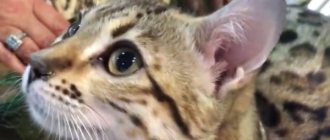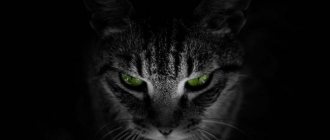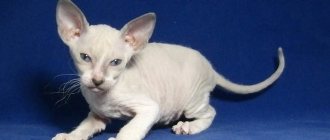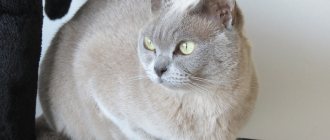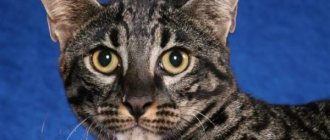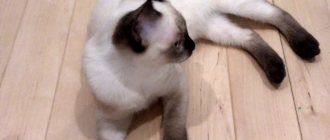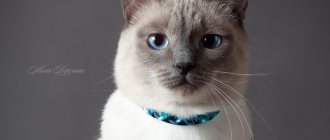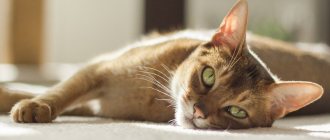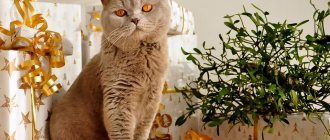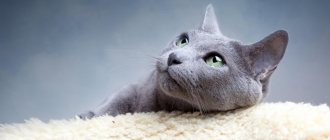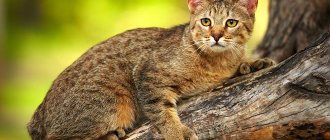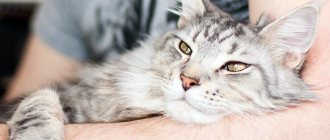The Bengal cat appeared as a result of crossing a domestic cat and a wild Far Eastern cat (lat. Prionailurus bengalensis). Something gray and nondescript could not come out of such a union. They differ in character and appearance from the beloved domestic purrs, but this does not mean that they are wild and dangerous. No, they are homey and smart, but they can be persistent if you don't give them what they need.
Playful, with a musical voice, they are nevertheless not suitable for every person and carefully evaluate the strengths and capabilities before buying such a cat. And from the article you will learn what habits this cat has, advantages, disadvantages, history of origin and how to care for it.
History of the breed
The Bengal cat is one of the few examples of a successful hybrid between a domestic and wild cat. It is believed that attempts to obtain the result of such hybridization were made back in the early 1960s.
But, confirmed data says that the history of the breed begins in 1970, when felinologist Jane Mill participated in the fate of several cats that were used in a genetic experiment.
Dr. Willard Centerwall studied the immunity of wild cats, which was so powerful that it resisted the feline leukemia virus.
He crossed them with domestic cats, studying the ways of inheritance of this property by the descendants of a wild cat.
When the experiments were completed, Dr. Centerwall did not destroy the litter, but found homes for the kittens. Since Jane Mill was interested in the idea of creating a domesticated hybrid between a wild and a domestic cat, she happily accepted Centerwall's proposals.
From the litter, she chose animals that inherited the features of a wild cat, but at the same time showed a tolerable character, which could be tamed in the end.
Note that Jane Mill (and then Sugden) first began experiments on cat breeding back in 1940 at the University of California, Davis, UC Davis, while studying genetics there.
Then, in 1961, while visiting Bangkok, she encountered these cats for the first time and fell in love with them.
She even brought one with her to her homeland and got a litter from it, crossing it with a domestic cat, but due to life circumstances she interrupted the experiment.
One can understand her enthusiasm when fate gave her the chance to work with this animal again. And although Dr. Centerwall supported her, the same cannot be said about cat lovers' associations.
Most catteries and organizations are strongly against crossbreeding wild and domestic cats, and even now, such a well-known organization as the CFA refuses to register Bengals. Although most international organizations began to recognize it since 1980.
So Mrs. Mill continued to work on the breed, but the work was not simple or easy. The cats wanted to breed with cats, and most of the male litters were sterile.
I was more lucky with cats; they could give birth to healthy offspring. Realizing that Mau, Burmese and Abyssinian cats do not have strong enough genetics, Jean searched all over the world for a suitable animal.
And in 1982, she was approached by the curator of the zoo in New Delhi (India), who drew attention to the luxurious wild cat that lived in the zoo next to the rhinoceroses. He was completely feral and managed to get a litter from him and her hybrid cats, which gave a new impetus to the program.
Generations of cats are numbered: F1, F2, F3 and the first numbers mean that the kittens were obtained from wild cats and domesticated cats.
But, from the fourth generation (F4), only a Bengal domestic cat and a male cat were allowed as parents for the breed to be recognized as pure.
In addition, the first generations were raised by enthusiasts, since these cats were not yet domestic in the full sense of the word, but retained the features and habits of the wild. Nowadays they are domestic, friendly, impressive pets, but still the breed is sometimes viewed critically. As Jane Mill herself said:
“If at a competition a cat of any breed bites a judge, it will be attributed to stress, but if ours bites, they will say it’s wild blood. Therefore, ours must be the cutest cats in any competition.”
Top most popular nicknames for boys
A popular nickname with meaning will reflect unique appearance features. character or funny habits.
Handsome Hunter doesn't mind going for a walk.
- Agate is complacent.
- Axel is serene.
- Cupid – giving sympathy.
- Ares is a fighter.
- Archie is brave.
- Valli is friendly.
- Helios is my sun.
- Hercules is a daredevil, heroic.
- Hephaestus is fiery.
- Damon is awe-inspiring.
- Zafar – victorious.
- Zephyr is the wind.
- Carat is powerful.
- Lancelot is a knight.
- Mars is the god of battle.
- Milan is good-natured. beloved.
- Orion – amber.
- Orestes is undaunted.
- Osman is heroic.
- Sapphire is priceless.
- Seraphim is a flaming angel.
- Hunter is the breadwinner.
- Caesar is imperial.
- Sherkhan is courageous.
Please note: felinologists advise first getting to know the habits and disposition of your pet and taking these nuances into account when choosing a name.
Breed standard
Skin
- Spotted or marbled, with a variety of colors, but gray or brown is the most common. There is also snow bengal (seal-linx), red-brown, pink, black and various brown shades. Note that not all of them are recognized as the breed standard. There are currently 5 recognized colors and 6 are under consideration.
- The fur is not as thick as that of ordinary cats, it is very soft, and is more reminiscent of rabbit fur in texture.
- Belly spotted
- The peculiarity of the fur is its golden effect, shimmering in the rays of the sun. This is the so-called glitter, the shine of wool, which was passed on to him from his wild ancestors.
Head
- The ears are small and round, unlike ordinary cats, which have pointed ears.
- In the dark, the eyes of a Bengal cat glow brighter than those of ordinary cats. This fact has not yet been recognized, but try comparing photos of these breeds.
- The eyes are large, very bright, of different colors, up to sapphire
Body
- Medium to large in size, with muscular legs, strong. Large, round pads. The tail is medium, rather thick.
- It takes up to two years for a cat to reach its full size.
- Males weigh 4.5 – 6.8 kilograms, and females 3.6 – 5.4 kilograms. The life expectancy of a Bengal cat is 14-16 years.
- They jump higher than ordinary cats and run well.
Voice
- Loud, has more intonation and sounds than other cats
Top most popular nicknames for girls
A melodious name for a girl will become a charming accent and will always please the ear.
Fashionista Gloria
- Aurora is the morning dawn.
- Agatha – glorious, valuable. kind-hearted.
- Aisha is a symbol of warmth and prosperity.
- Alice is an aristocrat, graceful.
- Amira is an heiress from the east.
- Angelica – dove, angelic.
- Ariadne is devoted, daring.
- Ariana is faithful.
- Astra is a star.
- Aura – being nearby.
- Athena is smart, brave.
- Aphrodite is amazing.
- Aelita is weightless, ethereal.
- Bagheera is a cunning, frantic hunter.
- Valencia is powerful.
- Hecate – dark, miraculous.
- Hera is the ruler, the founder.
- Gloria is famous, popular.
- Grace is simple, impeccable.
- Eva is proactive and lively.
- Jasmine is a delightful flower.
- Iris is multi-colored, multi-colored.
- Camilla is sophisticated.
- Cassandra is a seer and fortune teller.
- Cleopatra is royal.
- Lamia is angelic, soft.
- Layla - born in the night.
- Lilith is an imp, a devil.
- Lucia is clear.
- Mara – thoughtfulness, cleverness.
- Massandra – intense, powerful.
- Melissa is enterprising and active.
- Milady is the ruler.
- Milena is pampered and affectionate.
- Naira is freedom-loving.
- Naomi is amazing.
- Nevada - born of a winter's day.
- Olympia is spiritual.
- Ophelia is of blue blood.
- Pandora is magical.
- Roxana is a foreshadower of prospects.
- Sabrina is persistent and bright.
- Selena is the child of the moon.
- Sylvia is a nature lover.
- Stella is a celebrity.
- Felicia is the giver of good luck.
- Fiona is dairy.
- Sheila is incredible.
- Electra is juicy.
- Emma is the patroness of visions.
We recommend watching: 345+ nicknames for pets with blue eyes
Description
These mini leopards, with their sleekness, flexibility and spotted coloring, are a stark reminder that cats were wild 9,500 years ago.
And this wildness haunts people; they try again and again to create a domestic cat that will resemble a wild one. Judge for yourself: Egyptian Mau, Ocicat, Pixie Bob, Savannah Bengal.
These are developed, large athletes, their bodies are long, but not of the oriental type. Developed muscles (especially in cats) are one of the distinctive features of the breed. The legs are also muscular, of medium length, the hind legs are slightly longer than the front ones.
The neck is long and appears thick, but is in proportion to the body. The head is in the form of a modified wedge, with rounded contours, rather long than wide and looks small in relation to the body.
The eyes are oval-shaped, almost round, large. Eye color can range from gold, green to blue in point cats. The richer and deeper it is, the better.
The ears are small, short, wide at the base and rounded at the tips, set at the edges of the head.
Luxurious coat of medium to short length, close to the body, dense, but surprisingly soft and silky. Bright markings create a contrast with the main color.
Buy a Bengal kitten
Nurseries where you can buy a Bengal kitten are quite common in Russia. You won’t be able to save money on buying a descendant of a wild Asian leopard cat if you want to buy a purebred animal that will strictly meet the standards. In the nursery, the buyer will learn all the information about the future cat, its pedigree, and hear interesting facts about the character of the domestic mini-leopard.
The cost of the Bengal remains high precisely because of the difficulties with breeding. The first generation of Bengals will be infertile if they are males. Females of the first generation are crossed with Bengals and a second generation is obtained, where most of the males are sterile. In the third generation from the f2 female, only some males are sterile. The fourth generation are considered true representatives of the Bengal breed, and have a full range of characteristic skills and traits.
The price for a Bengal cat in Russia is:
- pet class
25,000-50,000 rubles; - breed class
50,000-100,000 rubles; - show class from
100,000 rubles
.
What to name a Bengal kitten
When a Bengali boy or girl arrives in the house, the family may have a number of names ready. But before you give the kitten a nickname, you should know that it must begin with the same letter as the name in the passport.
global $ads_google; //data-ad-slot=”2475549904″ $ads_google = empty($ads_google) ? false : true; ?> if ($ads_google == false) {?> $ads_google = true; ?> } ?>
Also, you should not give a new cat the nickname of your previous pet, this is not only a bad omen, but also a careless attitude towards the memory of a deceased or missing pet.
A long name is difficult to pronounce and difficult for a cat to remember. Hissing sounds are welcome, to which the cat will react most quickly. You can experiment and try calling the cat by different names. There is a chance that the animal will choose its own name.
Handy tables have been created with names that might be suitable.
| Girl | Boy | ||
| Julie Dosya Cleo Dotty Shelma Ivy Eva Aida Stesha Fanta Vikki Iksa Yesya Lika Liya | Almira Brandy Toffee Yuni Tori Lynx Klepa Cher Goldie Ulfi Bara Baksa Goldie Lucky Finka | Joshua Joe Alistair Leo Easy Bingo Ike Luntik Wirt Tory Rain Ride Whiskey Martin Ralph | Vince Rick Jacques Mort Indie Byte Drake Knight Spot Fima Gore Chen Zipper Gizmo Weiss |
Character
The first thing that scares people is, isn’t it dangerous to keep such a cat? Let us reassure you, later generations are no more aggressive than any other cats.
The domestic cat is playful, active and remains a kitten at heart throughout its life. Lovers say that they fly into the room with sparkling eyes and the expression: “Here I am!” Let's Play!".
Add to this curiosity and intelligence, this alloy often makes you break taboos. They are smart, which is not surprising, since their ancestors needed more than teeth and claws to survive in the wild.
Bengal cats behave like dogs; they come running when you call, bring toys for you to play with, and are capable of learning tricks.
Sometimes they learn tricks that you don’t like: how to open doors, taps, or flush the toilet. Playful until old age, they love to catch anything that moves, be it real mice or artificial ones.
Put this together and you get a cat that needs to know everything that happens in the area, with a high degree of socialization. They are not afraid of strangers and boldly explore, sniff, and examine.
However, you shouldn’t reach out to them; they might scratch you. They are always ready to play, love to climb as high as possible and do not like to sit still.
But, they love freedom and do not like restrictions. This can be on leashes and when they are picked up. This does not mean that they will rip you bloody, they will just run away when they try. Other completely domestic cats exhibit the same behavior.
Do you think that's all? Not at all. The influence of wild ancestors is so strong that they like things that ordinary cats cannot stand.
Firstly, they love water, like wild leopards (excellent swimmers), and play with the trickle of water running from the tap. Secondly, they eat different foods, with the exception of some fruits.
Some prefer to get a couple of paws wet every now and then, others may jump into the bathtub or get under the shower with you. It's a fun experience until they get out and run around the house.
Some may become so obsessed with water that owners have to lock bathrooms and toilets or they will open the taps and flush the toilets.
In the house, they become attached to one person, whom they consider the owner (if cats consider anyone the owner at all), but at the same time they spend time with all family members, especially when they call to play or eat.
Smart, active and curious, they need interaction with their owner, and woe to the one who cannot give it.
When a cat gets bored, he can tear things apart to see what they are made of, or open the door to the bedroom to find out what is being hidden from him. They like to hide things, so it’s better to put valuables in places where he can’t reach them.
They are quiet, but if they start making sounds, they can’t get by with just meowing. The range of sounds is large, and over time you will know when your cat is hungry, bored or wants to go for a walk.
Most pet Bengals get along well with other animals in the house, including dogs.
As for children, it is better that they are older and understand this animal, and you cannot drag it by its mustache or tail. They play with children without problems, but on condition that they are not abused.
Please note that the character of a cat is individual, and your pet may behave completely differently. But, they are smart, independent, playful creatures, and if you understand each other, you will never want another cat again.
How to help a kitten
Every cat owner wants to have a healthy pet. To avoid health problems for your Bengal cat, you need to provide proper care and disease prevention from the first days the kitten arrives in the family.
Even if an animal has hereditary problems, it is quite possible to provide a cat with a full life, for this you need:
- carefully monitor the appearance and behavior of the pet: activity, condition of the fur coat and skin, appetite and mood;
- at the first warning signs, consult a specialist;
- carry out all prescribed examinations on time - they will help to “catch” the onset of the disease;
- carry out all necessary vaccinations, regularly carry out treatment against ecto- and endoparasites;
- establish a strict diet: choose a diet in accordance with the age and individual characteristics of the Bengal cat, food should be fresh, rich in vitamins;
- ensure that fresh water is always available within reach;
- exercise more often, play with the baby, stroke him - emotional contact is very important.
If a kitten was born with one of the hereditary syndromes, massage and reasonable physical activity will help prolong its life and make it comfortable.
Maintenance and care
Bengal cats are unpretentious in keeping. This is a physically and mentally healthy breed, strong and nimble. They love to climb up and climb in general.
Moreover, the higher it is, the more interesting it is for them. To prevent damage to the furniture in the house, provide them with a high scratching post.
The more active he is, the healthier and happier he is, and you will save your nerves. You can walk with her on the street, they get used to the leash without any problems. As already mentioned, they love water, play with it and can be with you while you are in the shower. It is not advisable to bathe them often; they are already clean.
The coat is short, luxurious, silky and requires virtually no maintenance, just brushing once a week is enough.
The rest of the care is basic. Trim nails regularly, preferably weekly. If your ears look dirty, gently clean with cotton wool.
It is advisable to brush your teeth with cat toothpaste and take your cat to the veterinarian regularly for checkups.
The sooner you start brushing your kitten's teeth, trimming its nails and combing it, the easier it will be in the future.
Preparing for a swim
Half the success is quality preparation, especially when it comes to training an adult cat that has not yet experienced the “joys” of water procedures. You will need:
- 2 shallow but wide basins for water.
- Comb with large rounded teeth.
- Sponge.
- Capacity for pouring up to 250 ml in volume.
- Large bedspreads or sheets.
- Several thin ones and one bath towel.
- Gloves and thick clothing to protect the body.
- Water thermometer.
- Shampoo, if necessary.
- It’s very good if there is a “second pair of hands” to help.
Important! The cat should not be tied up while bathing. If your pet panics, he may hurt himself with the collar or leash.
Have you decided to get this breed?
Then these tips will be useful to you:
- Buy only from a nursery or reputable breeder
- Complete the purchase and documents for the animal
- Check your kitten's eyes, are they clean and clear? Make sure he doesn't have a runny nose
- Kittens should be picked up no earlier than they are 10–12 weeks old.
- There should be no diarrhea or its symptoms. Look under the tail, check that everything is clean and there is no redness
- The coat should be shiny, clean and not look greasy, this could be a sign of illness
- Find out if you have been vaccinated
- The kitten should be active, playful and curious. A little shyness when meeting people is normal. Avoid adopting lethargic kittens
- Take a closer look at other kittens and adult cats, do they look healthy and active?
- Is the room clean?
- Find out if the kittens are litter box and grooming trained?
- Please clarify whether genetic tests have been carried out for the presence of diseases?
Nicknames for real hunters
Does your pet want to play and hunt a toy mouse? Then a nickname in honor of a famous hunter or weapon would be appropriate.
Handsome Colt is preparing to hunt
- Artemis.
- Diana.
- Anat.
- Ammo.
- Benelli.
- Beretta.
- Bullet.
- Colt.
- Glock.
- Gunner.
- Hummer.
- Kimber.
- Musket.
- Ramington, Remmy.
- Smith.
- Wesson.
- Tank.
- Winchester.
- Aldo Leopold is an American hunter and environmental activist.
- Annie Oakley is an American marksman.
- Davy Crockett is a national hero.
- Daniel Boone is a popular American trapper.
- William Buffalo Bill Cody - buffalo hunter.
- Jesse James is a famous tracker.
- Theodore Roosevelt was an American president who was fond of hunting.
- Saxton is a bugbear in Yellowstone.
- Winston Churchill was an English prime minister who loved to hunt.
- Wyatt Earp is a famous sheriff.
Feeding
Bengal cats are carnivores, they are neither omnivores nor herbivores. Over the years, cat owners have forgotten about this fact.
If you look at commercial foods, you will see that they are low in meat and high in corn, soy, wheat, rice, and potatoes.
Since these types of cat food are only 50-60 years old, it is unlikely that they would have time to turn into omnivores.
So, why do they contain so many plant components?
The answer is simple: they are cheap .
- Do these foods provide enough for the cat to survive? Yes.
- Do these foods provide enough for a cat to thrive? No.
- What are the alternatives to commercial feed? Natural feed, meat and fish.
Just give your cat more natural food.
It is surprising when the owners are perplexed.
How? Only meat? And raw too? Yes.
What could be more natural for her? Or did you think that for the previous 9000 years cats ate exclusively canned food and dry food?
What does chirping mean?
Almost all cat breeds chirp.
There are several cat breeds that chirp much more and louder than other cat breeds.
One such cat breed is the Bengal cat.
Bengal cats make this cute sound frequently and much louder than most other cat breeds.
That's why I say:
Bengal cats are not ordinary cats. In fact, Bengal cats have many characteristics and requirements that other breeds do not have. For this purpose, if you have a Bengal cat, you should definitely check out our Bengal cat checklist.
Bengal cats make this sound frequently and louder because they are more vocal than other cat breeds.
The chirping of cats is directly related to their hunting instincts.
The fact that Bengals have stronger hunting instincts than most domestic cats explains why they often chirp.
All cats chirp, regardless of their breed or age.
Cat chirping is more of an "excited sound" that cats make than an actual sound used for hunting.
They make this sound when they spot something they think is prey.
Bengals often chirp when hunting birds or squirrels.
However, they can also chirp when they are in a frenzy over their toys and favorite food.
Sometimes Bengal cats also chirp with excitement when they meet their owners after a significant time has passed.
Simple feeding rules:
- 80-85% meat (chicken, rabbit, beef, lamb, lamb, etc.)
- 10-15% edible bones (except tubular ones, such as chicken bones, let's give the neck, keel, joints)
- 5-10% tripe (various internal organs)
- cut into small pieces for kittens and larger pieces for adult cats
- always make sure that the meat is fresh, buy only from trusted sellers
- most cats prefer meat warm or at room temperature
- you can also give fish, eggs, kefir, cream and other foods that your cat loves
As for cat food, including dry food, you can feed it only, but such food will be far from what your pet needs.
Give a variety of food and your Bengal will grow big, beautiful and healthy.
Nicknames by color
You can use your pet's color as inspiration. Take a look. What color or pattern is dominant?
Baby Ambre
- Icy.
- Snow.
- Weist.
- Neja.
- Whitey.
- Janus.
- Snowball.
- Belka.
- Belle.
- Ice.
- Winter.
- Snow Maiden.
- Eliza.
- Blackie.
- Haze.
- Algeria.
- Pepperino.
- Cherry.
- Imp.
- Volcano.
- Demon.
- Blueberry.
- Blackie.
- Blackberry.
- Naomi.
- Panti.
- Bagheera.
- Agate.
- Toffiffi.
- Cake.
- Jaguar.
- Panther.
- Cheetah.
- Speck.
- Charlotte.
- Carrie.
- Bengal.
- Desert.
- Jungle.
- Silvia.
- Argenta.
- Metallica.
- Frost.
- Sable.
- Frosty.
- Diamond.
- Crystal.
- Pearl.
- Perla.
- Ryzhka.
- Ryzhulka.
- Sunny.
- Yasenka.
- Morkovkin.
- Paprika.
- Chilista.
- Caramel.
- Iris.
- Mandarin.
- Medic.
- Spring.
- Apricot.
- Pumpkin.
- Spark.
- Zlatka.
- Goldilocks.
- Yantarka.
- Aina is a flame.
- Bestia.
- Hephaestus.
- Antimony.
- Ocher.
- Scarlett.
- Cinnamon.
- Carmen.
- Ruby.
Health
Like all cats obtained from wild animals, Bengals are distinguished by enviable health and a life expectancy of up to 20 years.
They do not have the inherited genetic diseases that plague hybrid breeds.
Before purchasing, make sure your cat is F3-F4 generation, as the first generations are too wild cat-like and can be difficult to control.
It is difficult, if not impossible, to meet first-generation cats in our latitudes and you have nothing to worry about.
What should you not do when accustoming your pet to water?
Some actions of the owners can lead to the animal becoming stressed from bathing and subsequent attempts at washing will become impossible. The main mistakes when accustoming a cat to water procedures:
- It is not recommended to wash the kitten in the bathroom; it is better to use a basin. A small plastic container with low walls will be accepted normally by animals. When he sees the high sides of the bathtub and rising water, his instinctive fear of drowning turns on, so a small basin is preferable.
- Do not open the tap to full power or raise the shower head too high above the animal. Drops falling and scattering in all directions cause anxiety and discomfort.
- It is forbidden to plug your pet's ears with cotton wool, as it can cause irritation.
- Punching and screaming are the worst things you can use to restrain your pet. The cat will associate the procedure with pain and fear.
- You should not tie your cat while bathing. If she panics, she may hurt herself trying to jump out and get rid of the collar or leash.
- The animal should not be washed in too hot or cold water.
- The sooner the procedure is completed, the better.
Born to kill, survive, and fight for territory, wild cats were domesticated and experienced all the “charm” of civilized life. If you don't bathe your cat, will it be dirty? No, this is not a stupid question, think about it. Yes, a pet needs to be bathed when it gets into something that can be toxic when licked, “caught” parasites, before an exhibition, that’s all for valid reasons. How to accustom a cat to water, at what temperature to bathe and what to prepare for?
Intelligence
When talking about the features and character of Bengal cats, it is important to note their intelligence. Representatives of this breed have the instincts and cunning of their predatory ancestors, the highest adaptability, intelligence and intelligence. Bengals are very attentive and observant, capable, like dogs, of remembering and following commands.
This domestic cat with the appearance of a mini-leopard very sensitively captures all the nuances of the owner’s mood and strives with all her might to correct him, attracting him to her pranks and games.
